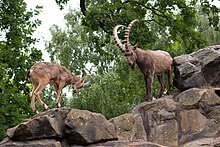Siberian Ibex
| Siberian ibex | |
|---|---|
 |
|
| Female and male at the Berlin Zoologischer Garten, Germany | |
| Scientific classification | |
| Kingdom: | Animalia |
| Phylum: | Chordata |
| Class: | Mammalia |
| Order: | Artiodactyla |
| Family: | Bovidae |
| Subfamily: | Caprinae |
| Genus: | Capra |
| Species: | C. sibirica |
| Binomial name | |
|
Capra sibirica Pallas, 1776 |
|
The Siberian ibex (Capra sibirica) is a species of ibex that lives in central Asia. It has traditionally been treated as a subspecies of the Alpine ibex, and whether it is specifically distinct from other ibex is still not entirely clear. It is the longest and heaviest members of the genus Capra, though its shoulder height is surpassed by the markhor.
Siberian ibexes are large and heavily built goats, although individual sizes vary greatly. Males are between 88 and 110 cm (35 and 43 in) in shoulder height, and weigh between 60 and 130 kg (130 and 290 lb). Females are noticeably smaller, with heights between 67 and 92 cm (26 and 36 in), and weights between 34 and 56 kg (75 and 123 lb). The nose is straight in profile, the neck short, and the back straight. The neck is also particularly thick and muscular in males, but much less so in females. Both sexes have beards, although the male's beard is more pronounced, and those of females are sometimes absent altogether. Both sexes also possess a large scent gland, about 3 cm (1.2 in) across, beneath the tail.
The female's horns are relatively small, and grey-brown in colour, measuring an average of 27 cm (11 in) long. Those of fully-grown males are black and typically measure about 115 cm (45 in), although in extreme cases they can grow to 148 cm (58 in). Both sexes have circular rings around their horns that represent annual growth, but males also have large transverse ridges along the front surface. The exact shape of the horns varies considerably between individuals.
The colouration is also variable, from dark brown to light tan, with some reddish individuals. There is usually a stripe of darker hair down the centre of the back and onto the tail, and some males have saddle-like patches on the back in the winter. The undersides are paler, and, in the winter, mature males becoming much darker with white patches. Females and infants are generally more bland in colour than the adult males, and do not always have the stripe down the back. Siberian ibexes typically moult between April and July, developing their paler summer coat, which continues to grow and become darker as the year progresses, reaching the full winter condition around December.
Though some recent authorities treat the species as monotypic, others have recognized four subspecies, based mainly on differences in total size, size of horns and colour of pelage:
...
Wikipedia

